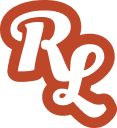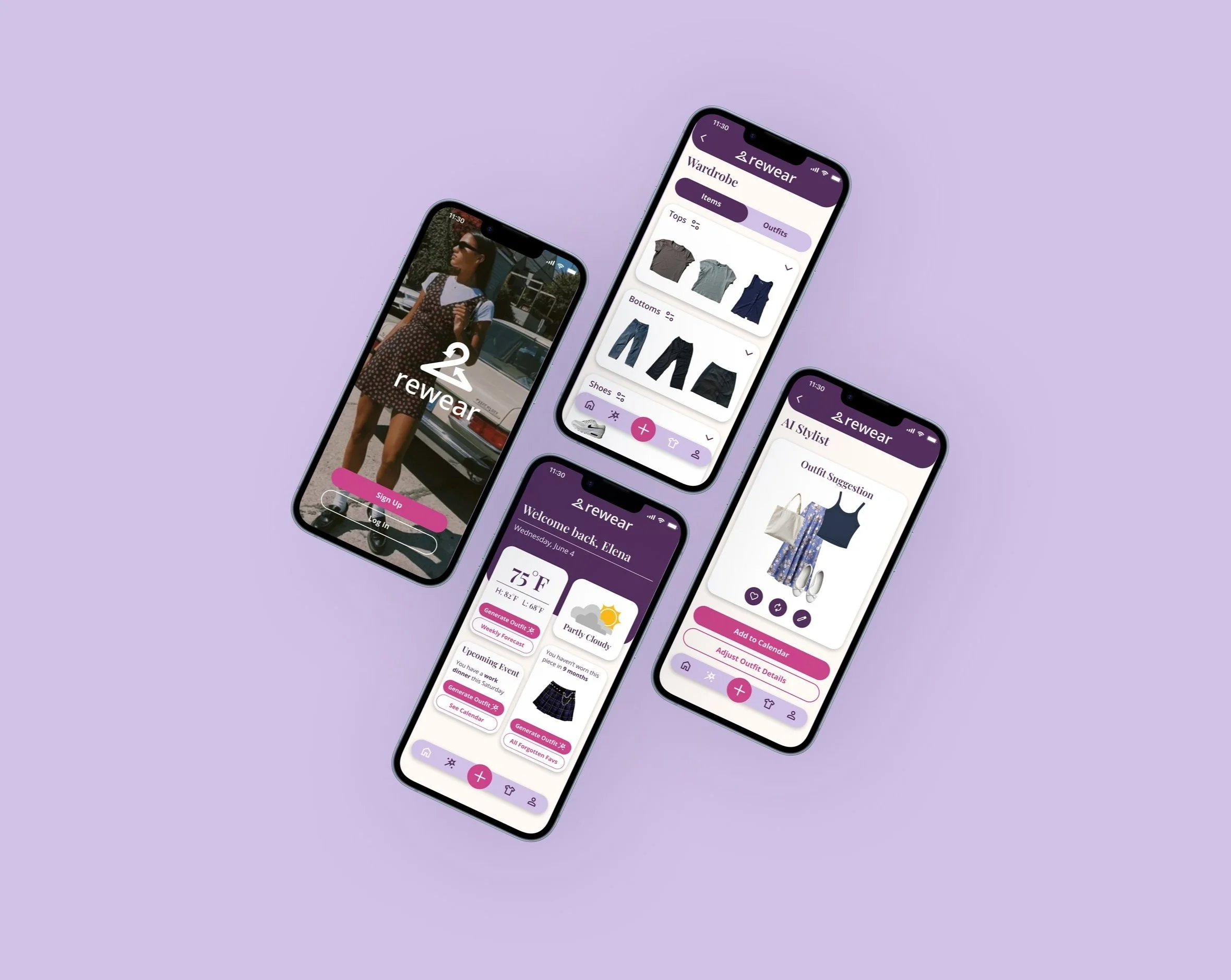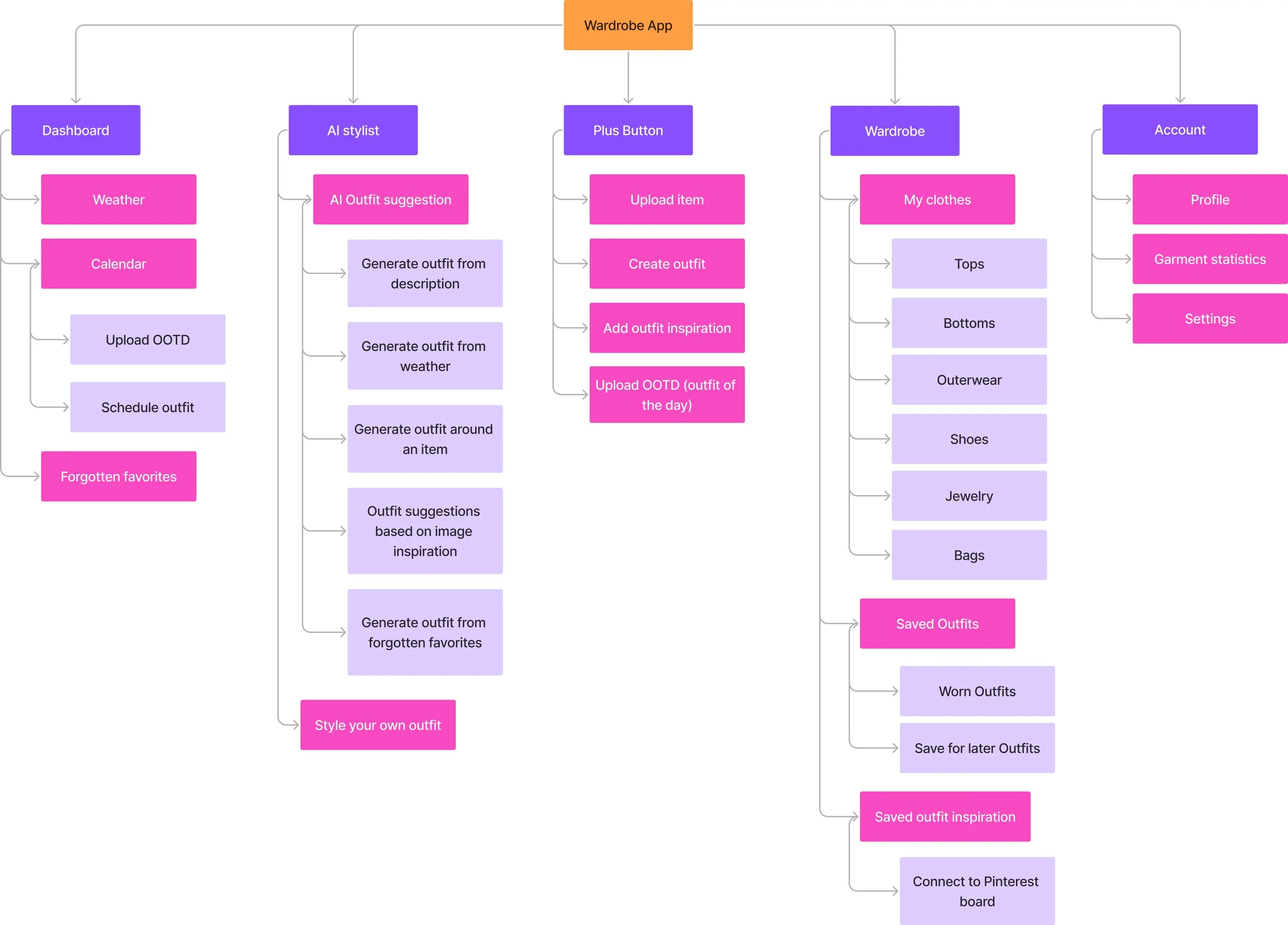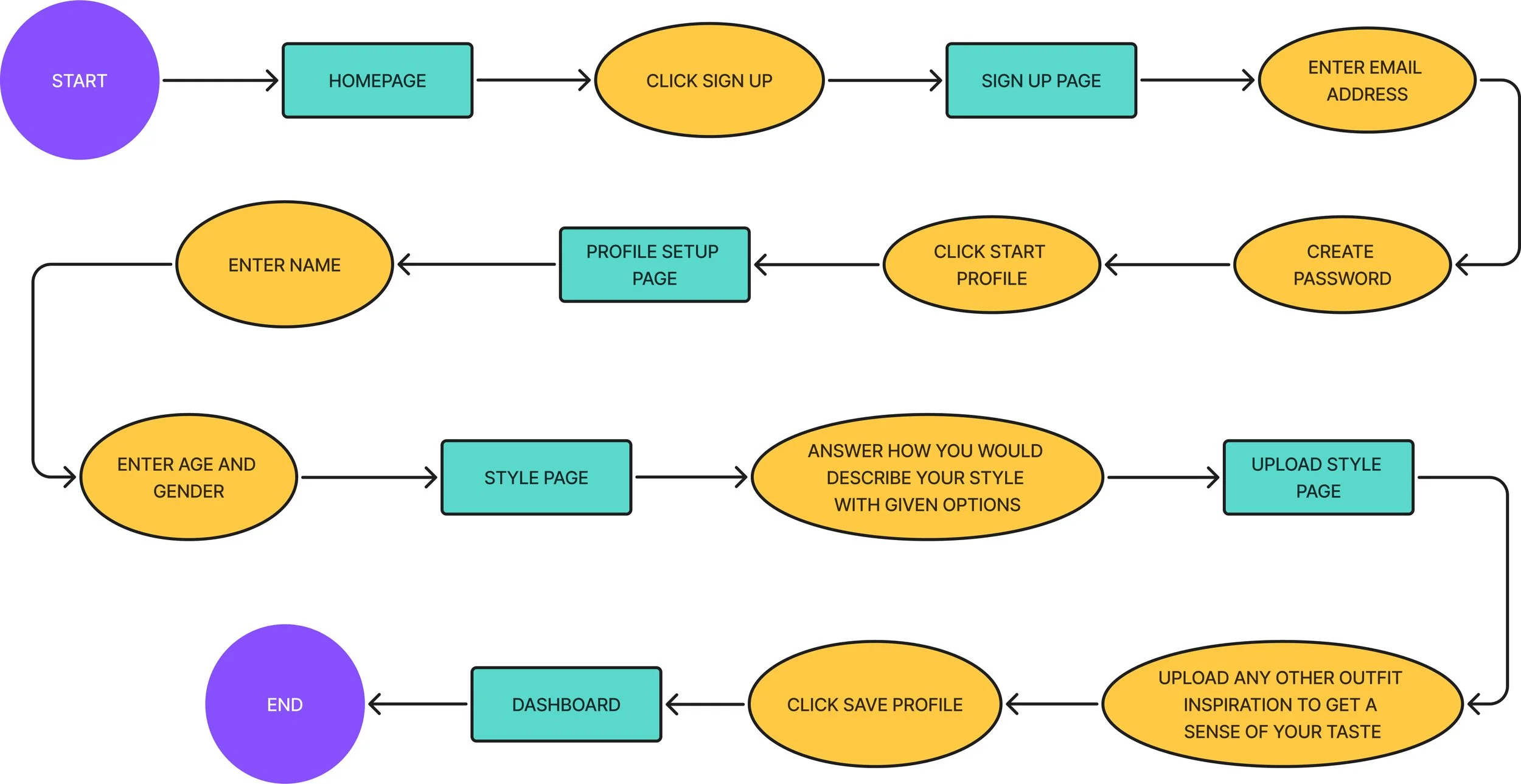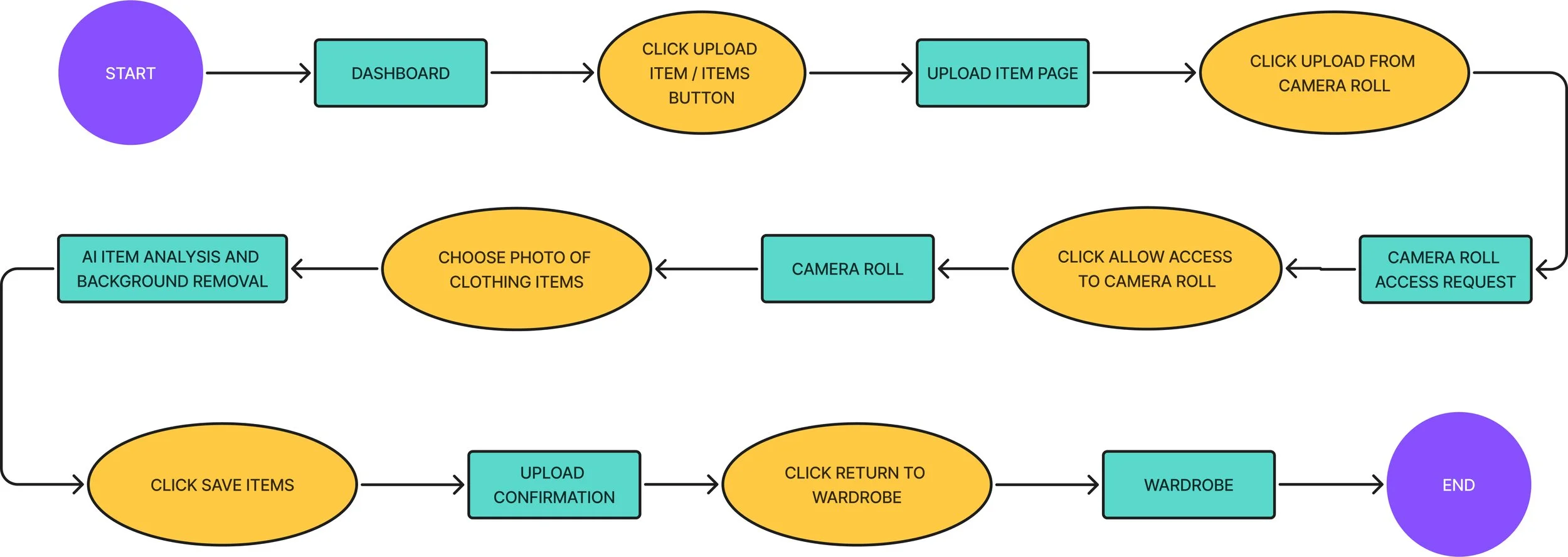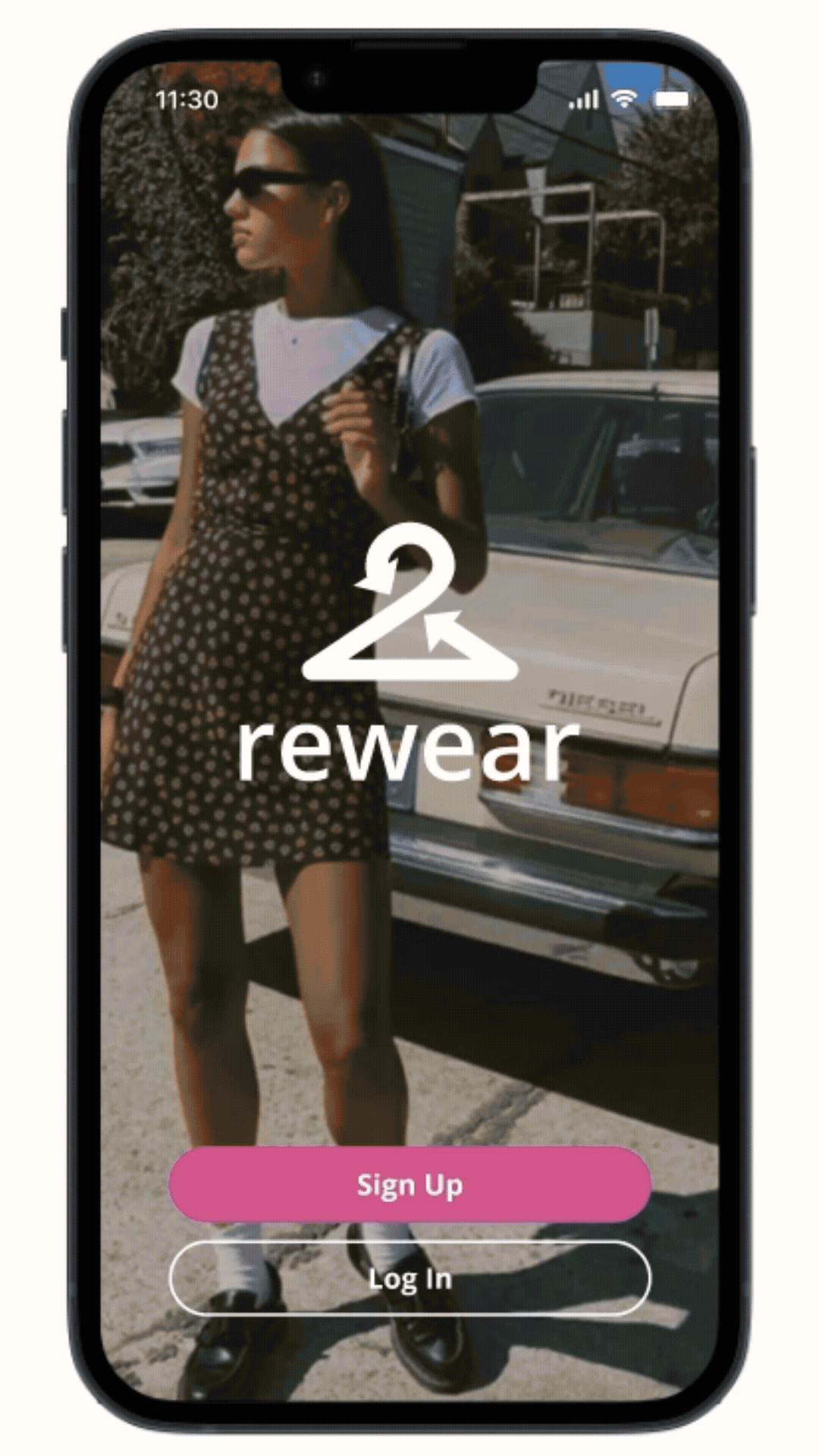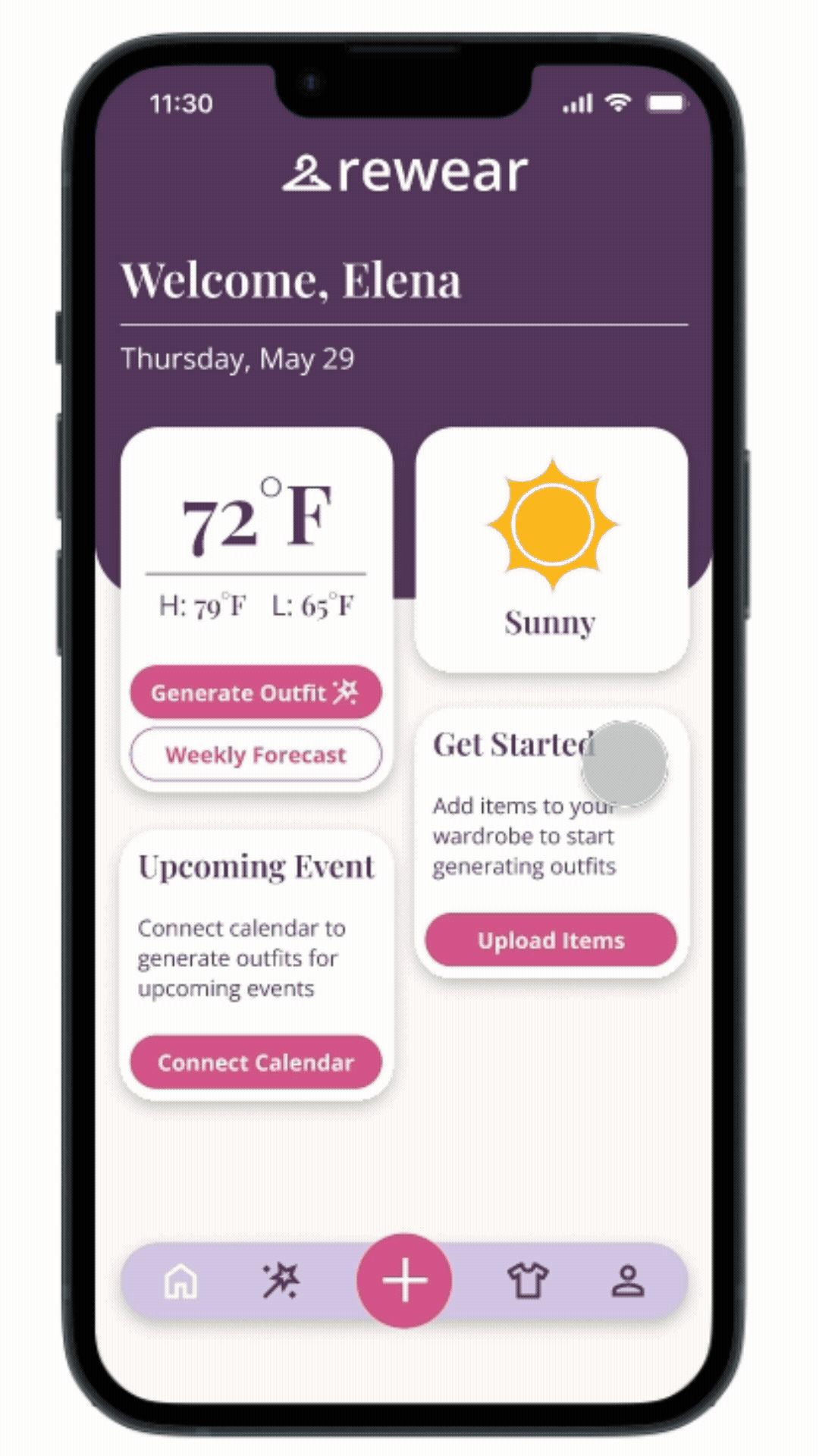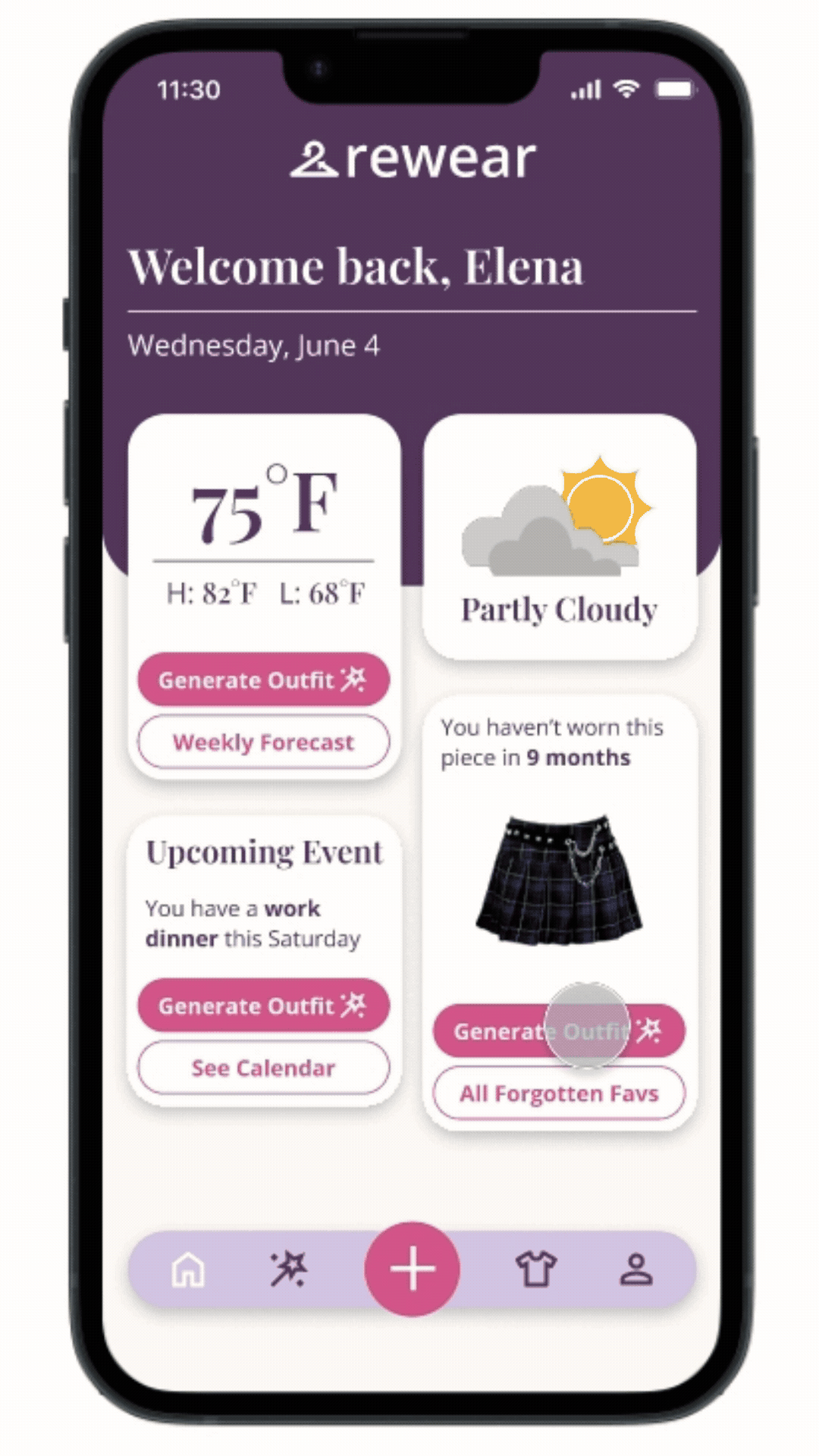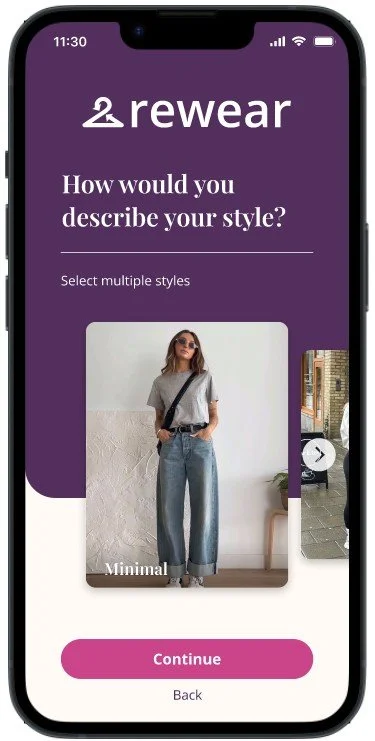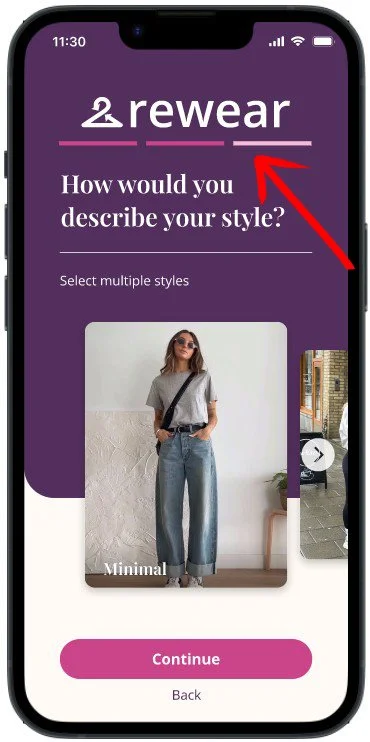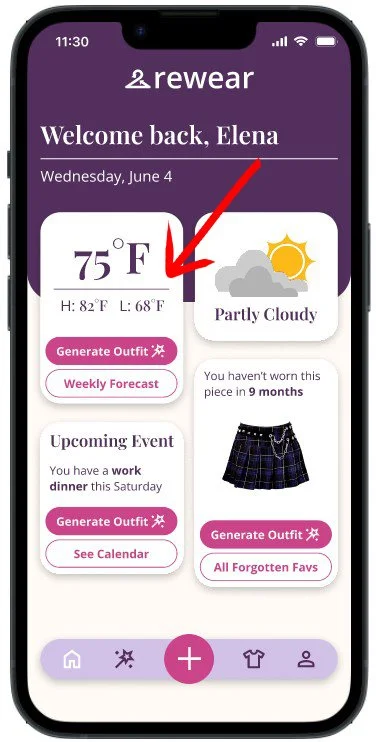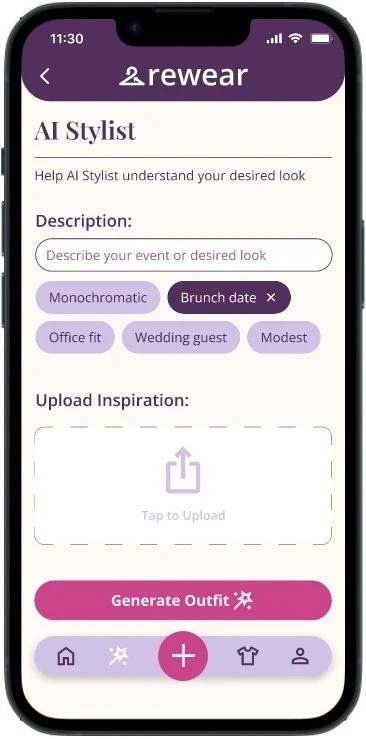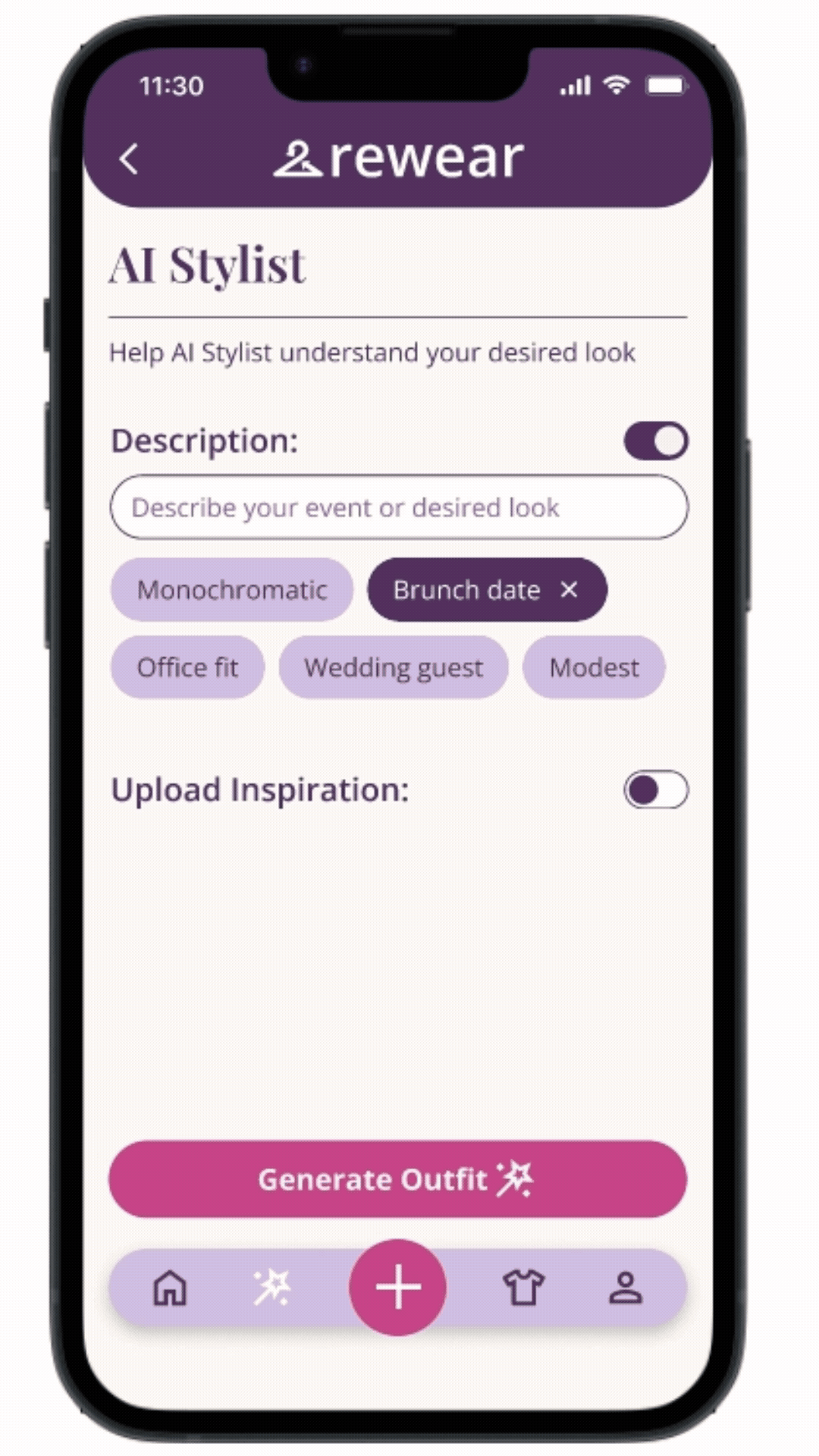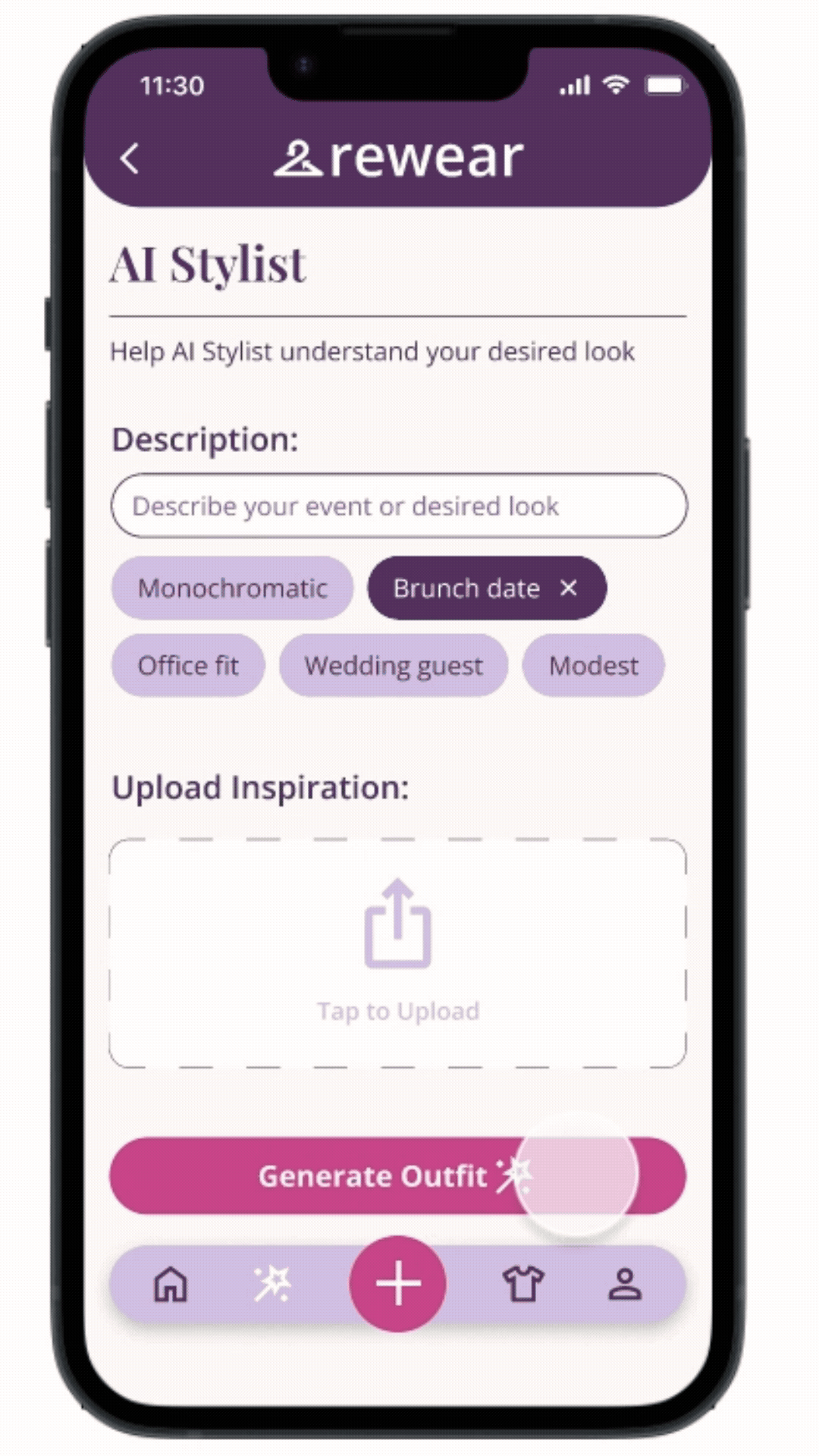How I built a smart closet app that uses AI to revive unworn clothes and cut fashion waste
Rewear
Role:
UX/UI Designer
Brand Designer
Project Type:
End-to-End Mobile App
Duration:
100+ hours
Tools:
Figma
FigJam
It is a common occurrence for people to claim they have nothing to wear, when in reality, the average adult has close to $300 worth of unworn clothes in their wardrobe. A study by Stitch Fix UK showed 80% of adults admitted to wearing the same clothes over and over. This can lead people to believe they need new clothes, instead of making the most of what they already own.
How can we dress more sustainably?
Overview
Empathize
People often wear the same outfits and leave piles of clothes forgotten and unworn in their closet. Instead of finding new ways to wear those clothes, they might instead go buy something new, further contributing to overconsumption.
Problem
We want to understand why users underutilize existing clothing in order to develop strategies that encourage more sustainable wardrobe use.
Research Goal
Competitive Analysis
What’s already out there?
Compared and contrasted other wardrobe organization apps on their strengths, weaknesses, opportunities, and threats.
Whering, Acloset, OpenWardrobe
Provide outfit scheduling and calendar
All allow users to organize items by category, season, or occasion
Community features to interact with friends
What are they doing well?
All AI performance can be inaccurate and inconsistent
Acloset’s free tier is very limited
None have strong desktop compatibility
Where are they lacking?
User Interviews
What do real people need?
I conducted remote and in-person interviews on 5 participants who identify with the problem of wearing the same clothes and forgetting about what is in their closet.
Affinity Mapping
What did I learn?
Insights and observations from interviews fell into 3 main categories
Wardrobe Visibility / Utilization - users tend to forget clothes that aren’t easily visible, users want to utilize their full wardrobe, users need a more efficient way to organize their clothes, users struggle to deal with unused clothing
Struggle with Outfit Planning - outfit planning is a stressful experience for many users, users need help dressing for the weather, users need help dressing for specific events, users are influenced by social pressures when choosing an outfit, users desire style development
Tool Usability / Automation Needs - users desire apps that are quick and easy to set up, user suggested ideas for wardrobe app related features
Users struggle to use their full wardrobe and plan outfits, but have avoided wardrobe organization apps due to lengthy set up processes of existing apps
Key Takeaway
Define
Persona
Users need a way to rediscover forgotten items in their closets because they tend to wear the same few outfits and overlook pieces that aren’t immediately visible.
POV + HMW 1
How might we help users easily rediscover hidden or forgotten clothing items in their closets?
How might we make it more enjoyable for users to explore what they already own?
Users need a way to plan outfits based on weather and events because they want to feel confident and prepared without overthinking each day.
POV + HMW 2
How might we reduce the mental load of daily outfit planning for users?
How might we recommend outfits that align with a user’s daily agenda or events?
Ideate
Develop an app that allows the user to see forgotten clothing items and generate outfits quickly without extensive setup
Solution
What are the most important features to include to achieve this goal?
Feature Roadmap
Prioritize the AI outfit creation and forgotten favorites reminders to generate outfits with ease and utilize more of the user’s wardrobe
Include AI detection and tagging when uploading clothing to the app to speed up setup time
Site Map
How should the website be laid out?
Conducted a hybrid card sort and used overlapping responses as the framework for my sitemap
Prototype
What are the user’s goals?
Task Flows
Task #1: Sign Up & Create Profile
Sign up and profile creation sequence
Choose style preference to tailor outfit suggestions
Task #2: Upload Clothes
Upload pictures of clothing for AI to analyze and tag
Task #3: Outfit from Forgotten Favorite
AI Stylist creates an outfit based on items user has not worn recently
Wireframes
Now let’s design
Low Fidelity
Hand drew key screens for each flow to take into mid-fidelity
Explored different versions of each to get a sense of the look and feel and determine what design would best meet the user’s needs
Mid Fidelity
Brought screens into Figma for mid-fi versions of each flow
Branding
What should Rewear look like?
The name ‘Rewear’ refers to users’ desires to create outfits that better utilize their full wardrobe
Logo Design
I explored many ideas for the logo, many revolving around the idea of reuse through a cycle motif. I also wanted to incorporate something related to clothing to signify that it is a clothing app. The final design embodies a hanger that contains arrows, representing the reuse of clothing.
For color palette, I thought a soft purple would work well for representing mindfulness which is one of my brand values. A soft color along with a stronger pop of color, like a deep purple or a bright pink, represents empowerment which I want people to feel through using my app.
For type, I chose the fun serif font ‘Playfair Display’ for headers and a simple sans serif for body. These types play to the app’s values of personalization and simplicity.
Style Tile
Let’s put it all together
High Fidelity Wireframe
In designing these screens, I focused on having a simple look as to not overwhelm users. I wanted it to feel like users were walking through an organized closet. I took inspiration from several other fashion/wardrobe related apps in the layout and visual design of the screens.
Sign Up + Create Profile
In creating a profile, users can choose what style best fits them and even upload outfit inspiration from Pinterest or their camera roll to allow the AI Stylist to personalize generated outfits.
Users can upload images with multiple articles of clothing and AI will detect and tag each item of clothing to add to their wardrobe, saving users from adding each article manually.
Upload Items to Wardrobe
AI Stylist
Users can use the AI stylist to generate an outfit from a ‘forgotten favorite’. Outfits can be quickly generated from the dashboard, or more preferences can be added to tailor the outfit to a specific event, theme, color, etc.
Test
5
Participants
5 users participated in usability testing using my Figma interactive prototype.
100%
Success Rate
Users easily completed all the tasks with minimal errors in a timely manner.
5/5
Ease of Use
User’s thought the prototype was intuitive and easy to navigate.

Where can Rewear be improved?
Usability Testing Results + Iterations
I learned about several fixable pain points in my participants’ process of testing the prototype that regard small changes to improve the flow
Participants wanted to see what happens when non task related buttons are pressed so that they can explore the website in a realistic way.
1. Allow exploration
2. Progress bar
Users desired a progress bar to see how long the profile creation process will be.
Before
After
Users desired the low and high temperatures for the day along with current temperature.
3. See high and low temperatures
Before
After
4. Remove unnecessary toggles
Unnecessary toggles were removed to see full outfit details page upon selection. Toggles create an extra step in the process that might waste the users’ time.
After
Before
5. AI loading page
Loading page helps users see when the AI is being powered.
Before
After
Future Iterations
What are next steps for Rewear?
Add friends and share outfits - users recommended a feature to add friends and share outfits to coordinate for shared events
Ability to modify color scheme - users suggested having the ability to change the color scheme of the app if the current color scheme does not appeal to them
Multiple outfit suggestions at once - users suggested having one main outfit suggestion generated by the AI Stylist and several smaller suggestions beneath for more quick options
Key Takeaways
What did I learn from creating Rewear?
Overall, this project was one that I spent the most time on. Lots of aspects of the project took multiple iterations and sets of testing in order for the end result to be successful. I relate to the problem at hand, along with others close to me and many people I talked to. This made the project even more fun for me as I could see the direct impact it could have if it were to be made into a real app.
Narrow down the most important features for my persona based on time constraints and the project at hand
Spend time modernizing the visual design for a modern app
